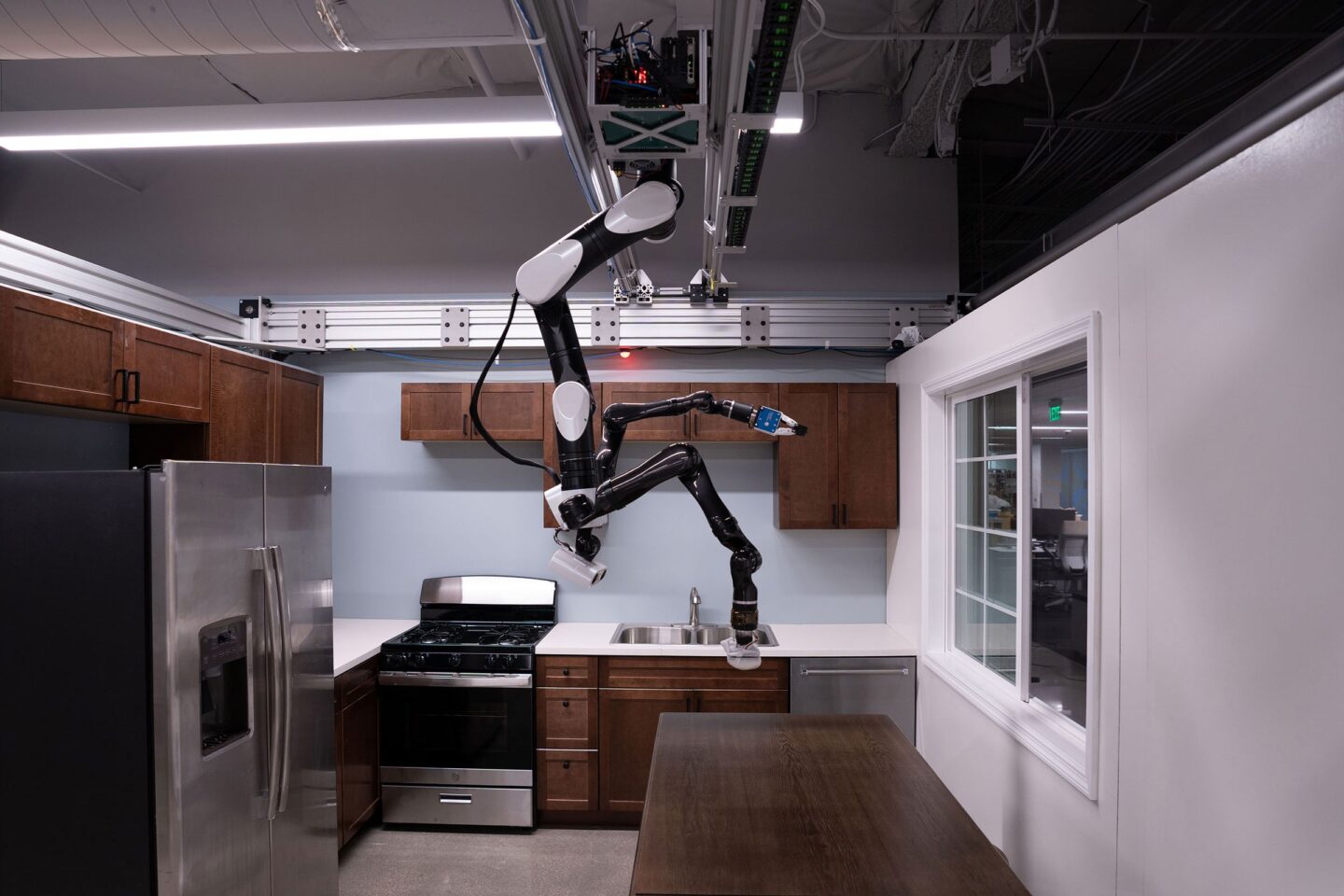The cleaning robots live inside a mock home located at the Toyota Research Institute in Los Altos, California.
Copyright by www.wired.com
 At Toyota, researchers are experimenting with prototypes that swoop from the ceiling to take care of chores with the help of machine learning. A Toyota robot suspended from the ceiling gets to work wiping a counter. Photograph: Toyota Research Institute Inside an ordinary-looking home, a robot suspended from the ceiling slowly expands arms holding a sponge, before carefully wiping a kitchen surface clean. Nearby, another robot gently cleans a flat-screen television, causing it to wobble slightly.
At Toyota, researchers are experimenting with prototypes that swoop from the ceiling to take care of chores with the help of machine learning. A Toyota robot suspended from the ceiling gets to work wiping a counter. Photograph: Toyota Research Institute Inside an ordinary-looking home, a robot suspended from the ceiling slowly expands arms holding a sponge, before carefully wiping a kitchen surface clean. Nearby, another robot gently cleans a flat-screen television, causing it to wobble slightly.
The cleaning robots live inside a mock home located at the Toyota Research Institute in Los Altos, California. The institute’s researchers are testing a range of robot technologies designed to help finally realize the dream of a home robot.
After looking at homes in Japan, which were often small and cluttered, the researchers realized they needed a creative solution. “We thought, you know, how can we use the ceiling?” says Max Bajracharya, VP of Robotics at TRI.
In another Toyota lab, in Cambridge, Massachusetts, robots practice picking up cups and plates and loading the dishwasher. In order to operate reliably, and without damaging anything, the robots rely on artificial intelligence algorithms that learn how to grasp objects correctly. The robot also uses a soft gripper equipped with a sense of touch that TRI developed.
Toyota does not have a timeline for commercializing its prototypes, but it is looking to be an early entrant in a potentially big market.
The Japanese carmaker launched the Toyota Research Institute with a $1 billion investment in 2015, betting that its expertise in car manufacturing could be parlayed into more advanced robotics for homes and workplaces. The Secret to Machine Learning? Human Teachers
Gill Pratt, the institute’s CEO, says the sensing, computing, and actuation technology found in modern cars essentially makes them simple robots. “A car is just a robot that operates outside on roads,” he says. “The purpose of a car is to amplify a person, and we think of robots in the same way—as amplifiers of human activity.”
Thank you for reading this post, don't forget to subscribe to our AI NAVIGATOR!
There is hope, especially in Japan, that robots will help care for an aging population in the coming decades. Besides keeping homes clean, robots might tend to people who need physical help, and perhaps even keep them company.
There is also an expectation that recent progress in AI will accelerate in advances in robotics. Today, most industrial robots are still fairly dumb, blindly executing repetitive motions. But this is starting to change, with new sensing and planning capabilities, as well as some use of machine learning. […]
Read more: www.wired.com


The cleaning robots live inside a mock home located at the Toyota Research Institute in Los Altos, California.
Copyright by www.wired.com
The cleaning robots live inside a mock home located at the Toyota Research Institute in Los Altos, California. The institute’s researchers are testing a range of robot technologies designed to help finally realize the dream of a home robot.
After looking at homes in Japan, which were often small and cluttered, the researchers realized they needed a creative solution. “We thought, you know, how can we use the ceiling?” says Max Bajracharya, VP of Robotics at TRI.
In another Toyota lab, in Cambridge, Massachusetts, robots practice picking up cups and plates and loading the dishwasher. In order to operate reliably, and without damaging anything, the robots rely on artificial intelligence algorithms that learn how to grasp objects correctly. The robot also uses a soft gripper equipped with a sense of touch that TRI developed.
Toyota does not have a timeline for commercializing its prototypes, but it is looking to be an early entrant in a potentially big market.
The Japanese carmaker launched the Toyota Research Institute with a $1 billion investment in 2015, betting that its expertise in car manufacturing could be parlayed into more advanced robotics for homes and workplaces. The Secret to Machine Learning? Human Teachers
Gill Pratt, the institute’s CEO, says the sensing, computing, and actuation technology found in modern cars essentially makes them simple robots. “A car is just a robot that operates outside on roads,” he says. “The purpose of a car is to amplify a person, and we think of robots in the same way—as amplifiers of human activity.”
Thank you for reading this post, don't forget to subscribe to our AI NAVIGATOR!
There is hope, especially in Japan, that robots will help care for an aging population in the coming decades. Besides keeping homes clean, robots might tend to people who need physical help, and perhaps even keep them company.
There is also an expectation that recent progress in AI will accelerate in advances in robotics. Today, most industrial robots are still fairly dumb, blindly executing repetitive motions. But this is starting to change, with new sensing and planning capabilities, as well as some use of machine learning. […]
Read more: www.wired.com
Share this: